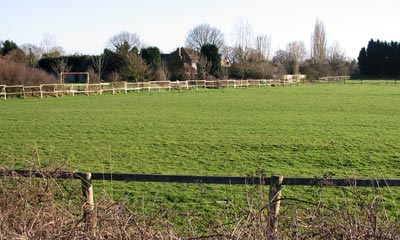Campaigners warn of housing threat
COUNTRYSIDE campaigners have joined forces with the National Trust in a last-ditch attempt to change a long-term plan for housing development, saying it poses “major threats” to the region's environment and heritage.
The Campaign to Protect Rural England (CPRE) and the heritage body said East Anglia needs saving from development overload, as the proposals in the Government's East of England Plan are for growth on “an enormous scale”. Their move comes as the plan nears completion after a mammoth public examination and could be subject to the Deputy Prime Minister's changes. They are demanding it is “greened” and have raised six factors they want addressed, while launching a petition calling for the region's needs to be met without “wrecking its countryside and quality of life”.

East of England chairman of CPRE Lawrence Wragg said: “Of course we accept there has to be change, but at the same time we must protect precious things which underpin our quality of life, our environment and heritage.
“We must act now to save the region's beautiful open landscapes, woodlands, wildlife, natural resources and historic towns and villages.”
Last night, the two organisations told the EADT the issues in Suffolk and mid Essex they think should be addressed as priorities in the plan, which shapes development over the next two decades.
Richard Ward, director of the Suffolk Preservation Society - the county's branch of the CPRE - said where there is a major shortage of lower-cost homes in rural areas of Suffolk, like Lavenham and Elmswell, the proportion of affordable housing in developments could need to be increased to 50% or more, compared to the current target of around 33%.
The limits flooding puts on growth in the county should also be taken account of in the plan. Mr Ward said some areas of the coast, such as Felixstowe seafront, could be unsuitable for new development but district councils are continuing to grant planning permission.
He said: “One issue that is pertinent to Suffolk is that we are a county with a very special environment - the built environment and the natural environment. We need to ensure that those planning new development realise what makes Suffolk special.
“We need a comprehensive Integrated Landscape Strategy for the whole of Suffolk. That would inform the decision-makers where development should or should not go in the next 20 years.”
David Williams, spokesman for CPREssex, described the plan as “creeping urbanisation” and said smaller villages in north Essex would grow in size.
Keith Turner, area manager for the National Trust, said the proposals as they stood risked unsustainable amounts of development, which will have long-term effects on internationally-important green spaces.
Airport expansion at Stansted would “impact dramatically” on mid Essex's Hatfield Forest, which the National Trust owns, in terms of noise and pollution. Over-flying of the Dedham Vale and disruption to the peace and tranquillity of that area would be a knock-on of that growth, he said.
“We need the plan to guide this process, balance economic growth with protection for our environment and heritage and offer investment in the future,” he added.
The current plan, approved by the East of England Regional Assembly in November 2004, includes proposals for 478,000 new homes by 2021 across six counties, industrial and business development and 67 road schemes.
If it goes ahead it will see more than 58,000 houses built in Suffolk and more than 123,000 in Essex.
Alan Richardson, the inspector who chaired the plan's examination in public over four months, is now writing a report for the Deputy Prime Minister John Prescott, who can then propose changes to the plan, which will be published some time in the autumn.
There then follows a final 12-week period of public consultation and the final version will be published in early 2007.
But a spokesman for the Office of the Deputy Prime Minister said: “We need new homes for the next generation and our ageing and growing population, but we need to make sure they are environmentally sustainable too.
“If we don't increase homebuilding from historic lows then only a third of 30-year-old couples will be able to afford a home of their own in 20 years time.
“Plans for new homes and jobs have strong environmental protections built in, including priority for brownfield development and protection of the Green Belt.
“The East of England is only 7.1% urbanised and even building new homes at the highest rate recommended by the Barker review would mean using just 0.38% of the total land area in the region.”
A spokeswoman for the East of England Regional Assembly added that the plan aimed to protect the region's major environmental assets and encouraged mitigation measures, such as environmental enhancements, where adverse impacts on other areas cannot be avoided.
She said the views of the CPRE were considered by the independent panel conducting the examination in public, along with the responses of more than 20,000 members of the public.
Anyone wanting to sign up to CPRE's petition should visit www.cpre.org.uk or email campaigns@cpre.org.uk.
The CPRE and National Trust want the plan to:
- Recognise that climate change, freshwater scarcity and flooding are limiting factors to development in the region
- Focus on building affordable housing rather than market housing, especially for rural communities
- Ensure protected green spaces, river corridors, flood plains, migration routes and wildlife corridors are included
- Guarantee existing Green Belt is protected and new Green Belt land proposed
- Retain the "good things" in the plan - such as the focus on 60% of all new development, including housing, being built on previously developed brownfield land or by reusing existing buildings
- Continue to stand against a further runway at Stansted Airport.
eadt.co.uk, 03.05.2006
